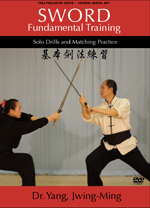Sword Fundamental Training – DVD by Dr. Yang, Jwing-Ming
This basic sword training DVD reviews the fundamentals about the weapon, taking common techniques and drills that should be applicable to all sword training. As always, Dr. Yang’s teaching style is excellent; his Engineering background provides a logical approach to his teachings of his wealth of martial arts knowledge. There is much knowledge to be gained from each of his books and DVDs that I have studied, and, now including this one, I highly recommend them.
As with many of his other DVDs, the drills and techniques are shown with Master Yang performing them, then with students of a variety of skill levels performing them. Yang will sometimes correct the students. I found the different displays and the corrections quite helpful during my own review of the lessons.
An outline of the DVD follows:
General knowledge: discusses Sword types, history, Chinese quotes about sword work and their meaning; “Ten thousand days of the sword.”
Sword key words and fundamentals techniques(27 most commonly used, based mostly on Northern Chinese style) (the notes after the techniques are my own memory joggers, not from the DVD):
- Cloud (Yun): protect the face;
- Sweep (Sao): opposite of cloud, attack the knees;
- Thrust (Chong)
- Bear or Block (Tuo, Jia): high block with (tuo) or without cut (jia);
- Cover, Press Down (Gai, Ya);
- Embrace (Bao): block in front of chest;
- Repel (Bo): inside block;
- Bind, Draw Back or Pull (Shu, Le, Dai, Chou, Ba, La): sword pulling back, with or without cut;
- Shake or Swaying (Yao, Pao);
- Hinder or Obstruct (Lan): intercept / block;
- Cut, Side Cut (Zhan, Heng): chop the head;
- Smear (Mo): circular cutting and pulling back;
- Point, Clip (Dian, Jian): Scissors;
- Pluck, Rise (Tiao, Jie, Ti): pulling sword up;
- Hook (Gua): block as your body moves backward;
- Wrap (Jiao): twirling spaghetti with the sword;
- Wash (Xi): open space to attack;
- Chop, Split (Kan, Pi): axe chop from top to bottom;
- Bore (Chuan): thrust forward;
- Block upward (Ge);
- Sink (Beng): wrist sinks down;
- File (Cuo)
- Intercept (Jie): Lan is defensive, Jie is cut at wrist;
- Slide Block and Cut (Liao)
- Stab (Ci);
- Slide (Hua, Ge);
- Horizontal Extend (Beng) or Expand (Hu0):
Solo practices
- Sway Left and Right (Zuo You Yao Bai): sway the sword with point 1/3 along sword as axis;
- Forward or Backward Slide Upward (Qian Hou Shang Liao): don’t forget to use the left hand for more control;
- Left or Right Making Circle (Zuo You Rao Quan) Horizontal (Ping Jian): clockwise and counter clockwise;
- Left or Right Making Circle (Zuo You Rao Quan) Vertical (Li Jian);
- Neutralize Up and File Low (Shang Hua Xia Cuo)
- Block Upward and Chop Downward (Shang Ge Xia Pi)
- Left or Right Coil the Wrist (Zuo You Chan Wan)
Partner/matching practices (Dui Lian)
- Follow-Neutralizing Filing the Wrist (Shun Hua Cuo Wan)
- Block Upward and Chop Downward (Shang Ge Xia Pi, Shang Jia Xia Pi)
- Up Intercept and Slide Downward (Shang Jie Xia Liao)
- Sideways Neutralize and Side Cut (Ce Hua Heng Kan)
- Carry Downward and Sweep Sideways (Xia Dai Heng Sao)
- Coiling Neutralize and Stab Horizontally (Chan Hua Ping Ci)
- Low Neutralize and Low Stab (Xia Dai Xia Ci)
- Wbirlwind (Zuo You Xuan Feng)
- Cloud Stab (Zuo You Yun Ci)
- Free Matching (Zi You Dui Jian)
Dr. Yang states the next skill level (after six months to a year of basics) is using the handguard to disarm your opponent). He also discusses at the end that in advanced training you must keep you mind off the sword and on your body. In addition, you watch the wrist moving instead of your opponents sword. He concludes with a reminder on focus and concentration (don’t blink!).



